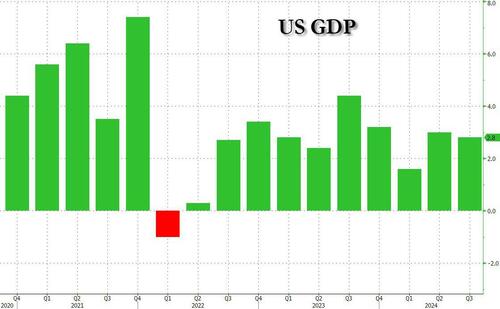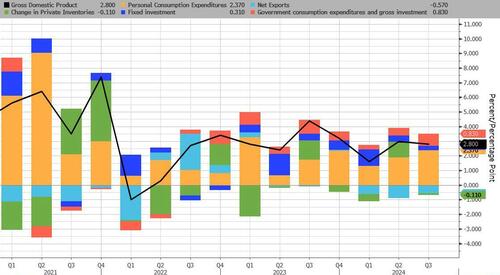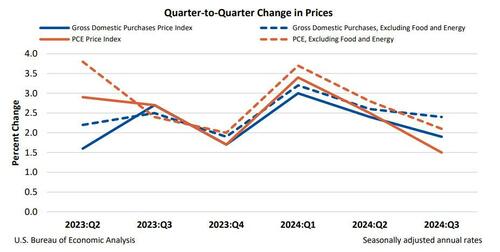Q3 GDP Unchanged At 2.8% In Second Estimate
Nobody expected today’s second estimat of Q3 GDP to be a riveting print, and nobody was disappointed when it wasn’t. After printing at 2.8% one month ago in the preliminary report, moments ago Biden’s outgoing Bureau of Economic Analysis reported that the second estimate of growth in the quarter ended Sept 30 was unchanged, at 2.8%, and in line with estimates; it was down fractionally from the 3.0% Q2 GDP print.
Here are the Q3 GDP details:
- Personal consumption rose annualized 3.5% q/q, below the estimate +3.7% (est. range +3.5% to +3.8%).
- GDP price index rose annualized 1.9% q/q, above the estimate +1.8% (est. range +1.8% to +1.9%).
- Core personal consumption rose annualized 2.1% q/q, below the estimate +2.2% (est. range +2.1% to +2.3%).
- Gross domestic income rose annualized 2.2% q/q
According to the BEA, compared to the second quarter, the deceleration in real GDP primarily reflected a downturn in inventory investment and a larger decrease in housing investment. These movements were partly offset by accelerations in exports, consumer spending, and federal government spending. Imports accelerated.
Looking at the change between the prelim print and the second estimate, the increase in Q3 GDP “reflected increases in consumer spending, exports, federal government spending, and business investment. Imports, which are a subtraction in the calculation of GDP, increased.“
Looking at the breakdown, we find the following:
- Personal consumption contributed 2.37% to the bottom-line GDP print of 2.82%, down fractionally from 2.46% in the firs estimate
- Fixed investment added 0.31%, up from 0.24% in the first estimate
- The change in private inventories subtracted 0.11% from the GDP print, a reduction from the -0.17% in the first estimate.
- Net trade was roughly flat, as net exports subtracted 0.58% from the GDP, up modestly from 0.55% in the first estimate.
- Government consumption was also flattish at 0.83%, down from 0.85%
And visually:
While stale, some were looking at the price data for hints to the December FOMC decision (a more timely release will be released in one hour when the core PCE number is published). According to the BEA, in Q2, Gross domestic purchases prices increased 1.9% in the third quarter, after increasing 2.4% in the second quarter. Excluding food and energy, prices increased 2.4 percent, after increasing 2.6 percent.
Personal consumption expenditures (PCE) prices increased 1.5% in the third quarter, after increasing 2.5% in the second quarter. Excluding food and energy, the PCE “core” price index increased 2.1% after increasing 2.8%, this was just below the 2.2% expected.
The GDP report also provided data on corporate profits which it found had risen in prior quarter: Y/y corp. profits were up 6.1% in 3Q after rising 10.8% prior quarter. Financial industry profits declined 0.4% Q/q in 3Q after rising 7% prior quarter. Federal Reserve bank profits up 10.7% in 3Q after falling 11.5% prior quarter. Nonfinancial sector profits rose 1.1% Q/q in 3Q after rising 4.2% prior quarter.
Overall, don’t expect anyone to spend too much time on this stale data as attention now turns to the core PCE report at 10am ET.
Tyler Durden
Wed, 11/27/2024 – 08:44
via ZeroHedge News https://ift.tt/zsEMN13 Tyler Durden




